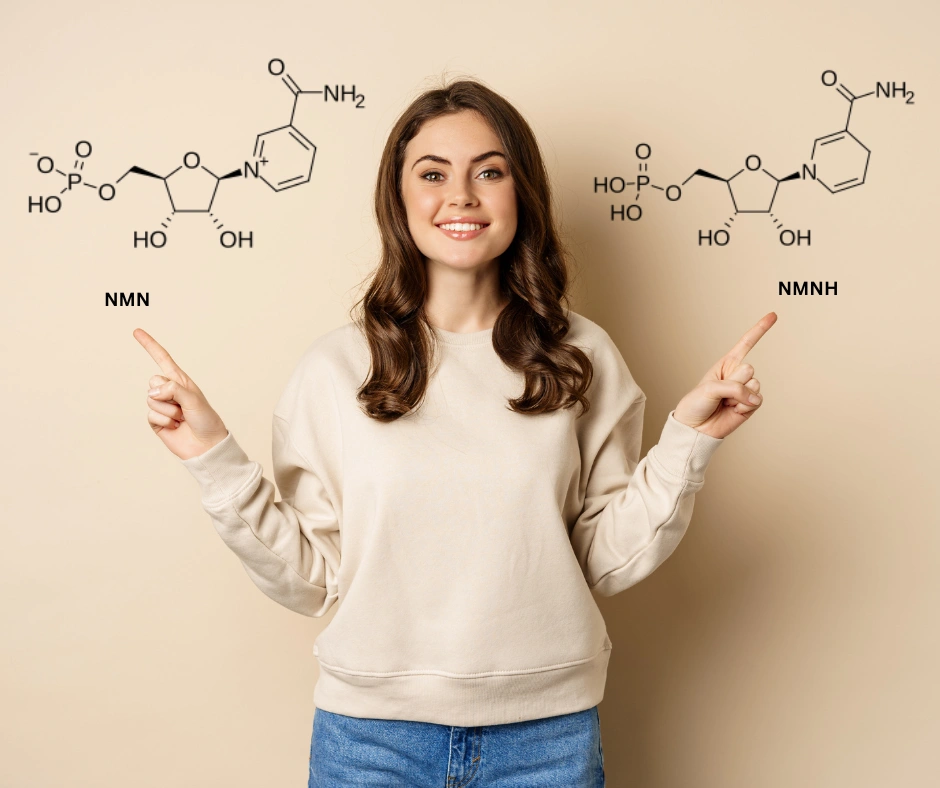Table of Contents
NAD+ levels in the body naturally drop by about 50% by middle age, which can affect energy, metabolism, and overall cellular health (1). This decline affects energy production, DNA repair, and overall cellular health.
That’s why supplements like NMN and NMNH are getting attention. Both aim to restore NAD+ levels and support healthy aging, but their research, structure, and stability are not the same.
Key Takeaways:
-
NMN is a clinically studied NAD+ precursor that helps support energy, metabolism, and cellular repair.
-
NMNH is the reduced form of NMN and may boost NAD+ faster, though research is still in the early stages.
-
NMN has a proven safety record in human studies, while NMNH’s effects remain largely untested.
-
Both compounds promote healthy aging by restoring NAD+ levels that naturally decline with age.
Disclaimer: This content is for informational purposes only and should not replace professional medical advice. Always consult a healthcare provider before starting any supplement.
NMN + RESVERATROL
Cellular NAD+ booster with ultra‑pure NMN and Resveratrol, at research‑backed doses.*
What Are NMN and NMNH?
 Both NMN and NMNH are NAD+ precursors that help fuel cellular energy, metabolism, and repair. The difference lies in their structure and how deeply each has been studied.
Both NMN and NMNH are NAD+ precursors that help fuel cellular energy, metabolism, and repair. The difference lies in their structure and how deeply each has been studied.
NMN (Nicotinamide Mononucleotide)
NMN is a naturally occurring molecule and a direct precursor to NAD+ (nicotinamide adenine dinucleotide), a coenzyme that fuels countless cellular processes. It’s derived from vitamin B3 and found in small amounts in foods such as broccoli, avocados, and milk.
Human and animal studies show NMN supplementation helps improve energy metabolism, insulin sensitivity, and overall cellular function. It supports DNA repair, mitochondrial health, and heart and brain function by replenishing declining NAD+ levels.
Because NMN has undergone several clinical studies, it is regarded as safe and effective for supporting healthy aging and vitality.
In most trials, NMN supplementation has shown a steady rise in NAD+ without significant adverse effects, confirming its strong safety profile.
NMNH (Dihydronicotinamide Mononucleotide)
NMNH, also known as reduced nicotinamide mononucleotide, is the hydrogenated form of NMN. It contains one extra hydrogen atom, which makes it a reduced form of NMN. This structural difference changes how it behaves in the body.
Early research from animal models suggests NMNH may raise NAD+ levels faster than NMN and influence metabolic pathways differently, including glycolysis and the TCA cycle (2).
Some findings also point to cell cycle arrest and suppressed cell growth, indicating that NMNH might regulate cellular metabolism in unique ways.
However, NMNH supplementation is still in its early stages. There are no completed human trials yet, and while results look promising in preclinical studies, more human data is needed to confirm its benefits and safety.
NMN vs NMNH: What Are the Key Differences?
The main difference between NMN and NMNH lies in their chemical structure and research maturity. NMN is a well-researched, oxidized form proven to raise NAD+ levels safely in humans, while NMNH is the reduced form that may increase NAD+ faster but lacks clinical validation.
Both NMN and NMNH play a role in maintaining cellular health and energy production, yet NMN remains the trusted choice because of its established safety profile and extensive human data.
Molecular Structure
NMN is composed of a nicotinamide base, ribose, and phosphate group, forming a stable molecule that converts directly into NAD+ (3).
NMNH differs by having an added hydrogen atom, giving it a reduced molecular structure (4). This difference changes how it interacts with enzymes during NAD+ synthesis.
While NMN’s oxidized form has been proven stable under standard conditions, NMNH’s reduced form is more reactive, making it less stable in neutral pH environments (5).
This may affect how it behaves once ingested or stored.
Metabolic Pathways
NMN follows the NAD+ salvage pathway, where it is converted into NAD+ by the enzyme NMNAT (6). This process is efficient and well understood in human physiology.
NMNH, on the other hand, appears to bypass some enzymatic steps that NMN requires. It may directly contribute to NADH and NAD+ pools, allowing for potentially faster NAD+ increases (7).
However, these mechanisms have only been observed in animal models, not human studies.
Absorption and Bioavailability
NMN’s absorption process has been documented in several human trials. It’s absorbed through the small intestine and enters tissues like the liver, muscles, and brain, where it supports cellular energy production (8).
Animal research suggests NMNH may have higher bioavailability due to its reduced form, allowing quicker cellular uptake (9). Yet, no clinical studies have confirmed this advantage.
Until such evidence exists, NMN remains the more predictable choice for safe and effective NAD+ restoration.
Research Status
NMN has undergone multiple clinical studies confirming its safety and potential benefits for metabolic health, cognitive function, and heart health (10). It’s recognized as a reliable dietary supplement with an established safety profile.
NMNH, by contrast, is still in early research stages. Preliminary research highlights promising benefits, including superior NAD+ elevation and influence on cell metabolism.
However, these findings come only from cell cultures and animal studies. More human trials are needed to validate its safety and real-world effects.
NMN and NMNH Benefits Compared
-v1762977548058.webp) Both NMN and NMNH play a key role in cellular health and energy production. They help restore NAD+ levels that decline with age and support various biological processes linked to metabolism, heart function, and DNA repair.
Both NMN and NMNH play a key role in cellular health and energy production. They help restore NAD+ levels that decline with age and support various biological processes linked to metabolism, heart function, and DNA repair.
While NMNH may offer faster NAD+ restoration in early research, NMN remains the better-studied option with clear evidence from human trials.
NMN Benefits
NMN supplementation has shown consistent and measurable results in clinical studies. It supports healthy aging, improves cellular metabolism, and enhances vitality by fueling NAD+ production across tissues.
NAD+ Restoration: Studies show NMN can raise NAD+ levels by up to 40% within 30 days, helping counter age-related decline (11).
Energy Metabolism: NMN fuels countless cellular processes that convert food into energy and sustain mitochondrial health (12).
Heart Health: Research suggests NMN supports vascular flexibility, reduces oxidative stress, and protects against age-related cardiovascular issues (13).
Gut Health: Long-term NMN supplementation may improve gut microbiota balance, increasing beneficial bacteria and reducing inflammation (14).
Cognitive Function: NMN may slow cognitive decline and enhance memory and focus by supporting brain energy metabolism (15).
Anti-Aging Effects: Through sirtuin activation, NMN may support DNA repair, cell longevity, and overall cellular vitality (16).
NMNH Benefits
NMNH, the reduced form of NMN, shows promising benefits in preclinical studies. Although it lacks human trial data, it may provide faster NAD+ increases and unique effects on metabolism and cell regulation.
Faster NAD+ Enhancement: Early research suggests NMNH may raise NAD+ levels more efficiently than NMN or nicotinamide riboside (NR) (17).
Metabolic Regulation: NMNH has been shown to suppress glycolysis and the TCA cycle, influencing how cells manage energy (18).
Tissue Protection: In animal studies, NMNH has helped protect renal cells under stress and promote cellular repair (19).
Potential Therapeutic Benefits: NMNH could offer deeper metabolic effects for future treatments, though more human data is needed to confirm these outcomes.
Potential Side Effects of NMN and NMNH
NMN is considered safe and well-tolerated in clinical studies, with only mild side effects like nausea, headaches, or fatigue reported in rare cases (20). NMNH, on the other hand, has limited human research, so its safety and potential side effects remain unknown.
Both NMN and NMNH influence core cellular functions, so it’s important to understand how the body responds to each. NMN has undergone several human trials confirming its strong safety profile and minimal adverse effects.
Most people tolerate it well, even at higher doses of up to 500 mg daily.
Commonly reported side effects with NMN include:
Temporary flushing or warmth in the skin
Mild nausea or stomach discomfort
Light headaches or dizziness
Occasional fatigue or sleep disturbance
NMNH’s safety data is limited to lab and animal studies. So far, no significant adverse effects have been documented, but that doesn’t guarantee safety for humans.
Its structural differences may cause unique biological interactions that still need to be studied. Until proper human trials are completed, NMNH should be approached cautiously.
If you have health conditions or take medications, it’s best to consult a healthcare provider before using any NAD+ precursor supplement.
NMN + RESVERATROL
Cellular NAD+ booster with ultra‑pure NMN and Resveratrol, at research‑backed doses.*
NMN vs NMNH: Which is Right for You?
-v1762977581853.webp) NMN is the safer and more reliable choice right now because it’s backed by human research and an established safety profile. NMNH shows promise for faster NAD+ production but still lacks clinical data to confirm its long-term effects.
NMN is the safer and more reliable choice right now because it’s backed by human research and an established safety profile. NMNH shows promise for faster NAD+ production but still lacks clinical data to confirm its long-term effects.
If you want results you can trust, NMN is the best option. It’s been tested in multiple human studies, showing improvements in energy metabolism, heart function, and overall cellular repair.
It’s also widely available as a dietary supplement and easy to combine with synergistic compounds like Resveratrol for greater impact.
NMNH remains an exciting discovery in early research. It may eventually offer superior benefits in NAD+ restoration, but the lack of human data means its real-world potential is still uncertain.
For most people, NMN supplementation provides consistent results for energy, mental clarity, and healthy aging. NMNH might be worth watching for future breakthroughs, but for now, NMN remains the gold standard for safe and effective NAD+ support.
Final Words
Both NMN and NMNH support cellular vitality and NAD+ restoration, but the difference lies in research depth and proven safety.
NMN is well-established through clinical studies, while NMNH is still in the early stages of exploration. If your goal is reliable support for energy, metabolism, and healthy aging, NMN remains the smarter choice.
At Omre, we’ve combined ultra-pure NMN with Resveratrol to create a formula that goes beyond ordinary supplementation. Resveratrol enhances NMN’s absorption and activates sirtuins for stronger anti-aging and antioxidant effects.
Together, they help restore energy, improve cellular repair, and support long-term health naturally.  If you’re ready to feel recharged from within, explore Omre NMN + Resveratrol, a trusted way to support your body’s vitality at every age.
If you’re ready to feel recharged from within, explore Omre NMN + Resveratrol, a trusted way to support your body’s vitality at every age.
FAQs
Can I take NMN and NMNH together?
There’s no research confirming the safety or added benefit of combining NMN and NMNH. Since NMNH lacks human data, it’s best to take NMN alone until more studies confirm that using both together is safe and effective.
Is NMNH more effective?
Early research suggests NMNH may raise NAD+ levels faster in animal models, but these results haven’t been proven in humans. NMN remains the more effective and reliable choice based on current clinical evidence.
Can NMN convert into NMNH in the body?
Yes, NMN can be converted into NMNH through natural cellular redox reactions. This process helps balance NAD+ and NADH levels, which are essential for healthy energy metabolism.
Are NMN and NMNH safe long-term?
Human studies show NMN is safe for long-term use, even at doses up to 500 mg daily. NMNH hasn’t been tested in humans yet, so its long-term safety remains unknown.
Should I take NMN with food?
NMN can be taken with or without food, though many users prefer taking it in the morning for better energy support. Some evidence suggests it absorbs well on an empty stomach.
How long does it take for NMN or NMNH to work?
Most people notice increased energy, focus, and vitality within a few weeks of NMN use. NMNH may act faster in theory, but without human trials, its real timing and effectiveness are still uncertain.





